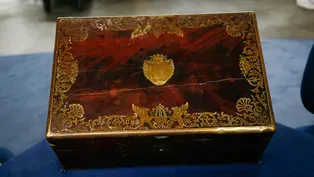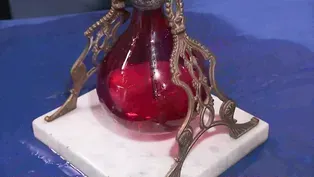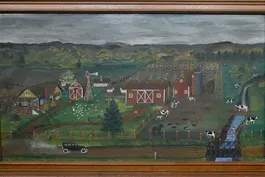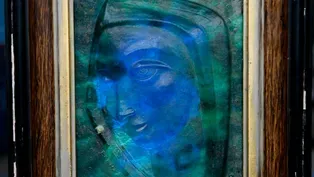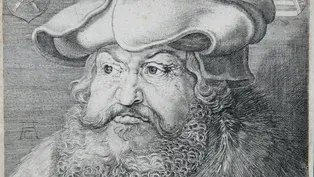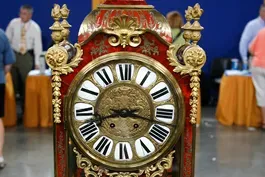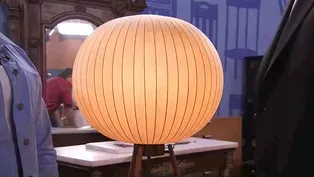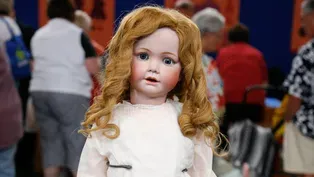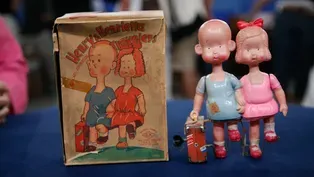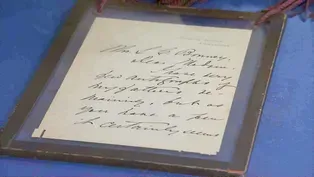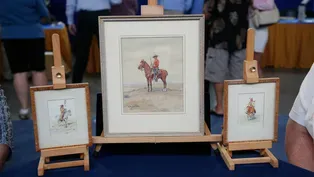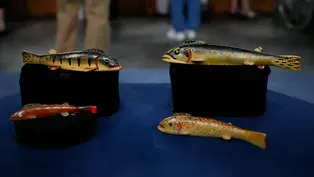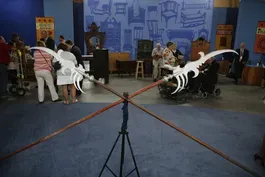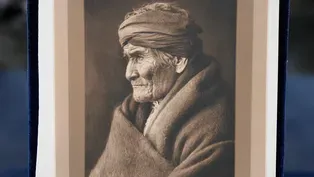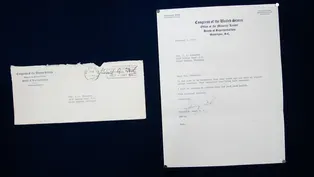
Vintage Grand Rapids, Hour 1
Season 26 Episode 18 | 52m 23sVideo has Closed Captions
Watch glorious Grand Rapids finds and guess which treasures have soared since 2008!
Guess which glorious Grand Rapids treasures have soared since 2008, including a Navajo Germantown blanket, a 1967 Gerald Ford letter, and an 1881 Jasper Cropsey oil painting. One has an updated appraisal of $150,000!
Problems with Closed Captions? Closed Captioning Feedback
Problems with Closed Captions? Closed Captioning Feedback
Funding for ANTIQUES ROADSHOW is provided by Ancestry and American Cruise Lines. Additional funding is provided by public television viewers.

Vintage Grand Rapids, Hour 1
Season 26 Episode 18 | 52m 23sVideo has Closed Captions
Guess which glorious Grand Rapids treasures have soared since 2008, including a Navajo Germantown blanket, a 1967 Gerald Ford letter, and an 1881 Jasper Cropsey oil painting. One has an updated appraisal of $150,000!
Problems with Closed Captions? Closed Captioning Feedback
How to Watch Antiques Roadshow
Antiques Roadshow is available to stream on pbs.org and the free PBS App, available on iPhone, Apple TV, Android TV, Android smartphones, Amazon Fire TV, Amazon Fire Tablet, Roku, Samsung Smart TV, and Vizio.
Buy Now

ANTIQUES ROADSHOW 2025 Tour!
Enter now for a chance to win free tickets to ANTIQUES ROADSHOW's 2025 Tour! Plus, see which cities we're headed to!Providing Support for PBS.org
Learn Moreabout PBS online sponsorship♪ ♪ CORAL PEÑA: Come along as "Antiques Roadshow" visits Grand Rapids, Michigan.
My grandmother was Gerald Ford's kindergarten teacher, but she would call him naughty little Jerry Ford.
Oh, my heavens.
♪ ♪ PEÑA: Back in 2008, we made a stop at the Great Lakes State.
There were great stories...
It was going to be either the clock or Italy, and we decided on the clock.
PEÑA: ...great surprises... Oh, my gosh, you're kidding.
This little thing?
APPRAISER: This little thing.
PEÑA: ...and great finds.
You have two of them!
PEÑA: But are they all still great?
Find out if the values went up, down, or stayed the same in this return to Grand Rapids, Michigan.
1939 was the golden age of films.
That year, they created one of my all-time favorites, "The Wizard of Oz."
Tell me about these movie props.
Where did you get them?
I purchased these swords from "The Wizard of Oz" movie from an auction company in California.
I paid $595 for them back in 1984.
"The Wizard of Oz" is one of the most beloved films based on the books by Frank Baum.
These swords belonged to the guards of the Wicked Witch of the West, and they actually were called Winkies.
Right.
The designer of the costumes was a very famous costume designer in Hollywood at the time, Adrian.
And he designed these spears, or pikes, as sometimes they're called, as part of the costume.
Now, there were probably about 15 of the Winkies, so it's hard to know how many actual spears exist.
In the 1970s, MGM Studios, that produced these films, held their own auctions, which sold such iconic things as the ruby slippers, as well as movie props like this.
Mm-hmm.
One of them sold in the late '90s for $7,500, and the price has escalated since then.
One now on the auction market would bring about $15,000.
Wow.
You have two of them!
And two of them would bring in excess of $30,000.
Excellent.
WOMAN: This toy was given to me back in the late '60s, early '70s, by a friend.
I used to pick her up and drive her around because she didn't drive.
Mm-hmm.
And so every now and then, she'd give me a little token for doing that for her.
Sort of for gas money?
Yes, mm-hmm.
So I've held it all these years... Mm-hmm.
...and I just love them, I think they're darling.
Well, it's Henry and Henrietta Travelers.
Do you know who Henry was?
Uh, yeah, I know Henry and Henrietta.
I remember the comic books.
Yes.
Mm-hmm.
And Henry had seldom spoke.
Oh, I didn't realize that.
Yeah, and I think that's one of the reasons he was so popular, because you didn't need to read a lot to enjoy them.
And you seldom see Henrietta.
I think she came along later in the comic books.
Okay, okay.
But this is a charming toy.
It was made in Japan in the 1930s.
The box is marked "C.K."
Mm-hmm.
Which is some sort of an initial for the maker.
But it's pretty hard to track down the actual names of some of these companies.
Okay.
It's made of celluloid, which is a very delicate material.
Mm-hmm.
Very easily damaged.
It is also a lithographed tin where the motor housing is, that little trunk.
Mm-hmm.
And it's a remarkable survivor.
Celluloid is flammable, it's fragile, it's very thin.
Wow.
But it was an amazing plastic kind of material that would retain great detail.
Okay.
I've always thought it one of the most charming toys.
A little boy and girl holding hands, walking off with a suitcase to somewhere.
Yeah.
(both laughing) And they do travel.
Mm-hmm.
We wind it up like this... (toy winding) Whoo!
Whoa!
There they go!
(both laugh) They are traveling.
Yeah.
So you got this as a token for gas.
Mm-hmm.
Well, this sells at auction for a minimum of $3,000.
(gasps) Oh, my gosh, you're kidding.
This little thing?
This little thing.
Oh... Oh, my gosh.
So... That's unbelievable.
I don't believe it.
(laughs) Well, especially with the original box.
Oh... Now, you had said something about the box being damaged.
Yeah.
If this is a toy that you love and you want to keep... Oh... ...it's worth $100 to have that, that box stabilized.
Wow.
Oh, geez, I'm going to cry.
(laughs) (laughing): Ah!
Oh, dear!
I had no idea-- I don't believe it.
(laughs) I just don't.
MAN: An antique dealer I knew that I had done some business with was retiring.
He asked me if I wanted to buy anything of his own collection.
So why did you pick this?
You know, I just had a feeling for it.
Like they say, it sort of spoke to me.
Well, you liked it.
Yeah, very much.
Well, there's a lot to like, I think.
Yeah.
I would attribute this painting to William Matthew Prior.
(clears throat): William Matthew Prior painted in Maine, but later on in Boston, and had a, actually a very successful business painting portraits.
I would think that this picture was painted probably sometime in the 1840s.
And the reason this picture is a little bit better than a lot of them that we see is that the kid is handsome.
He's a good-looking kid.
He has kind of a nice attitude, sort of an optimistic look on his face.
And this picture has the value of somewhere between $8,000 and $12,000, so you have very good instincts.
MAN: We've got an old fountain that we found in, uh, Battle Creek, Michigan, at an auction... APPRAISER: Uh-huh.
...about 20 years ago.
And, uh, we liked it, we bought it, and as we were leaving the auction, the people were just laughing at us that we paid so much for this thing that they had no idea what it was.
What it was-- what'd you pay for it?
We paid $325 for it.
This is almost a scientific instrument at the glass table.
This was made by Tufts, in Boston, and it's dated 1884.
Okay.
And it's cranberry glass, and it's, it's an amazing item.
Right.
Can you tell us how it works?
Well, what happens, it's like an hourglass.
You fill the top tray up with water, you fill the bottom piece with water, and then you flip it over.
And so when the water's up here on the top, it displaces itself, and then it shoots water in the air.
When it drains down, it lasts about 20 minutes.
You flip it around the other way, and it lasts another 20 minutes.
Well, it's a wonderful machine, and we're getting a little bath here.
And I think because of the interest in science and technology today, because of the interest in cranberry glass... Yeah.
...I would say it's a $3,000 item.
Really, wow, so...
Thank you for bringing it.
Thank you.
WOMAN: My son Eric talked my husband and I into going to an auction that we really weren't planning to go to.
And we fell in love with this clock.
We were planning to go to Italy for our 30th wedding anniversary and decided it was going to be either the clock or Italy, and we decided on the clock.
We thought we could enjoy it every day, and a trip to Italy would be over, so... Our son was kind of pushing for, for us to get it, also.
And we knew nothing about clocks.
Well, it's a French table clock.
It is signed down below here.
And if you do look up that maker's name, you'll find a couple of different generations who were clockmakers working in Paris.
The first Thuret generation was working very late in the 17th century and early into the 18th century.
And the second generation, his son, was working into the first quarter of the 18th century.
So, with that information, we would assume that the clock is of that period.
For that period, we would call this Boulle decoration, with this inlaid brass.
It's beautifully cast brass and gilded components.
The mechanism is a cast-brass plate, and then applied with enameled Roman numerals.
And then down below, we have a pendulum with a wonderful sort of starburst.
But as a connoisseur, we have to look beyond what we think this is and really study it carefully.
And if this indeed were one of those two generations of Thuret makers in Paris, we would expect this to be tortoiseshell.
We find that this is actually painted veneer.
So it gives us a hint that this may not be early 18th century or late 17th century.
And in fact, the more we look-- the fixtures, the castings, the screws that are used, the hinges-- it's more modern than either of those two makers, but it is still a magnificent clock.
Mm-hmm.
So, in fact, it is a clock not of that period that we would hope, but it's a clock from the 1870s.
It was made as sort of a revival piece from that late 17th, early 18th century group of makers.
Okay.
Now, it's a wonderful clock, it's a beautiful clock.
And you bought this at auction.
Mm-hmm.
And what-- you mind saying what you paid for it?
We paid $7,000 for it.
$7,000?
Well, you paid full retail for it at auction.
But I would have no problem at all appraising this for insurance purposes for $7,000.
And you have a lovely clock that you can enjoy for many years, whereas if you went on that holiday over to Italy, that would be over, you know, quite quickly.
Okay, well, thank you so much.
Thank you.
If this were a late 17th- early 18th century clock, we're talking in excess of $100,000.
WOMAN: About 20 years ago, I was with a friend, and we just decided to go into an antique mall, and I saw this bracelet.
And it didn't just speak to me, it shrieked to me.
APPRAISER: Uh-huh.
All I had was pocket change.
So I had to borrow the $64 for the bracelet from my friend.
And when I got home, I was so excited, I decided I would take it to a local jewelry store and have him tell me if it was a really valuable piece.
So I showed it to him, and he said, "Oh, those stones are fake, and this is made out of copper."
And he gave it back to me, and I was all deflated.
Mm-hmm.
So then I decided to send a picture of it to the author of a book on antique jewelry that I had.
Mm-hmm.
And he sent me back a nice letter saying that he thought that the bracelet was from the early 1800s and that it might be Swiss.
But he didn't give many more details than that unless I would come and show him in person.
Well, the first part of the story, the gentleman who said that this was fake and copper, was, was incorrect.
Oh, I'm so glad.
Um... What you have here is a bracelet from about the 1820s.
It is gold.
It's also enamel.
Now, the stones are what are called foil backs.
And what that means is that the stones had colored foil put behind them so as to even the color out amongst the stones.
Because during this period, it was hard to find stones that matched in color.
So many times, these stones are actually either colorless topaz or colorless quartz, that they would then put the pink foil behind to give this pink coloration.
But they are real stones?
They are real stones, yes.
The enamel work here is a type of enamel work called champlevé, where the surface of the metal is engraved.
The enamel is then laid into the surface of the metal and then sanded down flush.
I think the piece probably was made in Switzerland.
There are no hallmarks on the piece.
Many times, this type of enameling was referred to as Swiss enameling...
Okay.
...because a lot of this enameling came out of Geneva.
Now, it doesn't necessarily mean this was from Geneva or Switzerland, but it's indicative of that style.
Okay.
Uh, especially from that period.
The other nice thing about this particular bracelet, which is the, sort of the secret part of it, is that the bracelet opens up.
Yes.
And what we have in here is a compartment, and this central compartment has a pierced grill work in the center part.
This is what is referred to as a vinaigrette.
In the 18th and 19th century, when one was walking in the streets, the streets were not as clean as they are nowadays, and there were a lot of obnoxious smells and aromas that one would be assaulted with on the street.
And so a lady would have this on her wrist, and if she was feeling faint or smelled a bad smell, she could open this up and take a quick smell of a perfume or a lovely scent to sort of revive her senses.
Mm.
I would put an insurance value on this piece of approximately $6,000.
Oh, my goodness.
Thank you so much.
MAN: This is an etching print, which I believe may be a Dürer, but I'm not sure.
About 30-something years ago, my partner used to be an avid collector, um, although we were, uh, college students back then.
APPRAISER: And did he collect only prints, or was it across... Oh, no, he, he collected anything that he thought had, uh, a quality that he appreciated.
It is an engraving, not an etching.
Oh.
And the artist's name, you're right, is Albrecht Dürer.
He was a German artist who worked in the early 1500s.
He died in 1528.
Hm.
And he made a couple of hundred engravings and several hundred woodcuts.
Oh.
As well as a handful of etchings.
This is a portrait of one of his first patrons.
Hm.
One of the first men who supported his artistic endeavors.
And it's Frederick the Wise, who was Elector of Saxony in Germany.
And it's a portrait that he made-- you can see down here-- in 1524.
Here you can see, the first three lines are a dedication to Frederick.
Then you can see here: Frederick, Duke of Saxony.
This is all in Latin, by the way.
And then you can see that Dürer signed it here with his full name, Albertus Dürer.
NUR stands for Nuremberg.
That's the city where Dürer lived and worked.
And then "faciebat" is Latin for "made this."
So Dürer is saying, "I made this."
Again, on the print, you see up here Dürer's initials, A.D.
Most people looking at this might not assume initially that it's an engraving, because people are looking for a plate mark in an engraving or an etching.
And you don't have a plate mark on this sheet.
That's because it's been trimmed down right up to the edge of the plate.
That was something that was commonly done by collectors early on.
Oh.
From the 1600s through the 1900s, they would trim down their prints and paste them into albums.
It wasn't so much in style to frame up a print and put it on the wall, as we do today.
Mm-hmm.
Another neat thing about Dürer's portraits-- and actually a lot of portraits from this time, the Renaissance period-- is the belief that the eyes are the windows to the soul.
And if you look very closely at this print, on both pupils, you'll see four windowpanes.
So they take it quite literally that the eyes are the windows to the soul.
The plate for this print was made in 1524.
The plate survived Dürer's death and was printed from late in the 1500s and into the early 1600s.
I can tell from the quality of the printing and from the paper that it's on that this particular impression was made closer to 1600 than to 1524.
So it is a posthumous impression.
At auction, I would give this a value of $5,000 to $8,000.
Mm.
WOMAN: I bought it four to five years ago at an auction for $45.
APPRAISER: Do you collect paperweights?
Yes, I do.
I have about 40 or 50.
Well, it's a beauty.
And, and this one, we know it is French.
Oh, it is?
Okay.
It is 19th century, and it is one from the Clichy factory in France.
Okay.
And we know it's Clichy because of that center glass cane is a Clichy rose.
This would be called a spaced millefiori.
Pretty rare, and actually in excellent condition.
This weight, in a retail shop, $2,000.
Oh, wow.
That's good.
It's amazing.
It's a great piece.
Wow.
I'm really glad you brought it in.
Well, thank you.
That's great, thanks, wow.
(both laugh) My husband and I, uh, have been collecting Mid-Century Modern for a number of years, uh, since way back in the '80s, and, uh, we like more unusual pieces, and, uh, we found out about a piece from a dealer in Saugatuck, uh, near Grand Rapids.
And we were told that this is a prototype George Nelson lamp.
And we knew this was a George Nelson bubble, but we've never seen anything like this on the base.
You know, it's interesting, because George Nelson actually worked for Herman Miller right here in Western Michigan and did a lot of really interesting things.
I looked at this with a couple of my colleagues, and we do believe that it's a George Nelson prototype.
I've never seen it in the marketplace, and I do believe it's George Nelson.
This piece is great.
I think probably in today's market, this piece would bring between $4,000 and $6,000.
Wow.
Interesting, because I paid $280 for it.
(laughs) You did very well, you did very well.
They hung in my grandfather's home for many, many years when I was a child, and I've had them hanging in my home since the late '70s.
APPRAISER: Now, do you think he bought them?
On the back of one, I think, was, uh, written that, in my grandmother's handwriting, that it was a gift from somebody, but other than that, I, I really don't know much about them at all.
Well, they're really wonderful American Western watercolors by the artist Olaf Carl Seltzer.
Seltzer was actually born in Denmark in 1877, and moved to Montana, where he was a cowboy and sketched in his spare time.
He began studying art in Denmark at the age of 12, I believe, uh, which means that he was something of a child prodigy.
Wow.
And he became friends with the wonderful Western artist Charles Russell.
Okay.
And Russell became his mentor and friend, and the two of them went off sketching into the West.
But there's two generations of Western art.
There's the first generation, including Remington and Russell, and they were really capturing the vanishing West.
Okay.
Seltzer is the second generation, and he was relying a bit more on the myth of the West.
So his pieces are more imaginary and mythic...
Okay.
...in a way, than the first generation.
But he's an extremely popular and important Western artist, and the Western market is strong, continues to be strong, and continues to grow.
They're in quite good condition.
The smaller pieces of the Native Americans are probably a better subject.
The detail that you can see in the figures is quite extraordinary, and he was known for the great truthfulness that he would bring to capturing these scenes.
Uh, the scene in the center, the larger scene, one of our military experts tells me, is a Royal Canadian Mounted Police officer.
Oh.
In terms of the value of the pieces, the two smaller pieces I would estimate at between $6,000 and $8,000 apiece at auction.
Oh, you're kidding me.
Yes.
And the larger piece at between $8,000 and $12,000.
Oh, my word!
Wow.
That's amazing.
(chuckling): Just ama... That just blows my mind.
(laughs) MAN: This is a photograph that was taken by Edward Curtis.
And Edward Curtis was a photographer that headed west to, uh, capture the Indian lifestyle because it was rapidly disappearing.
He took a whole series of photographs, came back east, and in order to finance his next expedition, he created portfolios and then he offered those to contributors.
And the picture that we've got here is of Geronimo.
Mm-hmm.
Periodically, my wife and I would go to art galleries, and I saw this one, and of course right away recognized who it was, and I purchased it.
Well, Edward Curtis is known for a very ambitious undertaking that he called "The North American Indian."
This was a series of portfolios and books devoted to culture that Curtis recognized was disappearing and wanted to chronicle.
He did get support from Roosevelt and funding from J.P. Morgan, and this project took him over 30 years to complete.
Now, this particular photograph was done in 1905.
So it's at the end of Geronimo's life, Geronimo being an Apache warrior.
And what's interesting about this picture is that it's actually a copy.
Interesting.
The border around the photograph tells us that this is a sepia-toned border print.
It's a photograph that Curtis made of his own photograph.
And in fact, in the lower left corner, we can see an original inventory number that in the negative would be very clear.
But in this second-generation picture... Yeah.
...it becomes a lot fuzzier and somewhat illegible.
Now, the good news is... (chuckles) ...that Curtis authorized this photograph.
If we look at the lower right, we see that he signed it.
Mm-hmm.
And there are the letters "L.A." Curtis was actually working in Los Angeles for a period of time as a cinematographer and Hollywood photographer to raise money.
In the 1920s, he was still working on completing... Ah, interesting.
Uh-huh.
..."The North American Indian."
And we also see that it has Curtis's circle C, his copyright.
Uh-huh.
I see that there's an indication of what you paid for this print.
Yes.
(chuckling) And that is $25.
How long ago was that?
I believe in the... 1972.
Well, pictures of Geronimo are very scarce and very desirable.
In fact, though Curtis made thousands of images for "The North American Indian," this is certainly in the top ten of that group of material.
Wow.
And a conservative estimate at auction today is $10,000 to $15,000.
Whoa!
It's a great, great piece.
Thank you for bringing it in.
Wow.
Thank you for the information.
This is wonderful.
I'm going to have to hide it.
(both laugh) APPRAISER: Can you tell me how long you've owned your weaving?
MAN: About 40 years.
It was handed down to me by my aunt who lived in California.
Well, it was made by the Navajo Indians in Arizona and New Mexico, probably in the early 1880s, when the trains started coming out by the reservation.
It's woven with what we call Germantown yarns that were produced in Germantown, Pennsylvania.
They were commercially spun and commercially dyed yarns.
And as soon as the trains made their way out, these yarns became available to the Navajo.
They'd always been great weavers, and when they got Germantown yarns, they started weaving some real tour de forces.
Now, these were made for the commercial market.
They were woven specifically to sell to tourists, but it says nothing about the quality.
They were still absolutely beautiful, like the traditionally made weavings.
This one, I particularly like the overall pattern.
You've got a slight rip and, and badly done repair here, and you actually are missing the white border at the bottom.
Now, that takes away from its value.
The values of these have changed over the last few years.
I'm, I'm sorry to say that they've gone down.
A lot of them have come on the market.
I don't think that affects this one too much, because it's such a beautiful weaving.
I would, however, recommend getting the border fixed and getting the, the rip fixed.
If you were to sell this at auction as is, it'd bring about $6,000 to $8,000.
I think if you restored the border and the rip, you'd probably get about $8,000 to $12,000 for it.
Wow.
Well worth doing.
Thank you.
You're welcome.
I know it's Pewabic pottery, uh, like, early 1900s.
Where'd you get it?
Uh, online auction.
Mary Chase Perry, the woman who designed the base and the shade, did this really cool organic earthy thing in Detroit, especially early on, around 1905, when this piece was made.
Her vases are rare enough, but on top of that, she designed the shade, as well.
First time I've seen a complete base and shade by Pewabic from this early period.
You bought it online at an auction for, you said $2,200?
Yeah.
I mean, that was, that took me by surprise, because I feel like a set like this, uh, even with the Pewabic market gone through a, a, a few ups and downs, is certainly, uh, triple to four times that.
I mean, I would say between $6,500 and $9,500.
It wouldn't surprise me if it brought $10,000 or more.
WOMAN: It was a piece that belonged to my Great-Aunt Gertrude.
I love green, I love pink, I adore flowers.
That's probably why I got selected to inherit this particular piece.
And I really know very little about it.
It has this very unusual raised decoration here.
It's made with little clear glass beads.
They painted a background color.
Oh.
And then the clear glass beads were put on top.
Okay.
And then they were kind of melted together... Really?
...fused together on, onto the face.
Really?
And so that the color comes through on the design.
Oh, okay.
And that type of design is called Coralene.
It's most frequently associated with Nippon porcelain, which is what this is.
Oh, okay.
We believe that a retail price on this would be between $1,500 and $2,000.
(laughing): Are you kidding?
Oh, my gosh!
MAN: This hung in my grandmother's apartment on Lake Shore Drive in Chicago for over 40 years.
The pen went through relatives on her husband's side.
He got the pen in 1869.
His daughter wrote Alice Longfellow that she would like an autograph to go with the pen.
So Alice sent the letter.
And the autograph, she couldn't find one, so she cut one out of a book.
APPRAISER: It actually, from here, looks rather like the front of an envelope, but it's a perfectly genuine, uh, signature.
And it's a photograph of the famous author and poet Henry Wadsworth Longfellow and a quill pen that was evidently his.
Autographed manuscript quotations come up a lot for sale.
Uh, it's nice to have the pen, nice to have the photograph.
And this letter supports the provenance perfectly well.
And I would have thought an auction estimate on this package would be in the region of $500 to $1,000.
That's terrific.
That's terrific.
MAN: I was born up by Cadillac, Michigan.
Lived in a town, McBain, and my dad was a farmer.
And did a lot of ice fishing, uh, in the winter, because there was not a lot to do on the farm in the winter.
And, uh, he passed away when I was 15.
And I always liked these things.
I played with 'em a little bit, and it was one of the things that I took when we sold the farm and moved to town.
Of course, these are, these are by Oscar Peterson.
Yup.
But did, did you tell me that your dad bought them from Oscar Peterson?
Yeah, they tell me that my dad and my uncle, they, who did a lot of ice fishing, they would go to Cadillac, and I guess he sold these out of his garage.
They would go there and, uh, he'd have his whole garage hanging full of these-- some painted, some unpainted-- and that's where they would buy them.
Oscar Peterson was from Cadillac, Michigan, and it's my understanding that Peterson sold a lot of these to tourists.
Oh.
And then I guess he sold 'em to people like your dad that actually might have used them.
Uh, they look like they might have been in the water a couple of times.
Oh, yeah.
I even fished with them.
Oh, yeah?
They, they work rather well.
I say, did you catch anything?
No, not that I can recall.
But, uh, I know my dad speared a lot of fish around these, so... Peterson used imagination.
And the thing that, that's cool about his stuff, too, is that he did make a lot of them, but he didn't lose that enthusiasm for the way that he carved them or the way that he decorated them.
And I always look for the way he turned the mouth.
And one thing that you really got to watch out for with these is that, that there's a lot of reproductions and out-and-out fakes.
There's no doubt that these are the real bill right here.
And the larger they are, generally, the better they are.
And of course, condition enters into that, and you've got a few little places on the fence and stuff, but basically, really, really good paint.
What do you think they're worth?
Well, I've been told by guys they're worth $30 or different people.
I never had 'em appraised.
And then other people that I told I had 'em, they probably said, "Oh, maybe they're worth $500, $600, $700, $800, maybe."
But, uh, other than that, I didn't...
Okay.
Don't really know the value.
Let's start right here.
And I think in a retail setting, the $600 or $800 is probably accurate for that.
Now, both of the ones on top, this perch and the big trout, each one of those is easily worth $3,500 retail.
Each one?
Each one.
Well, that's a lot more... Because of the size.
Wow.
And, believe it or not, one of those trout like that-- What is he, about eight inches?
Yup.
Sold for $4,500.
Wow.
That's a lot more than I thought.
(both laughing) They were worth hanging onto.
And I carted them with me for a lot of years, you know, and...
It's the only thing I really got of him.
That's more than I really expected.
Yeah.
Makes me feel good.
WOMAN: She was my great- grandmother's doll, um, and then it was given to my grandmother, and then I inherited it.
I always liked it when I was little, and it sat in a china cabinet, but she never let me play with it.
What else do you know about her?
Um, that she's a Simon Halbig character doll.
I've looked in several books, but I can't find any information about her, about that mold number.
Right.
So, yeah.
Okay, and where was your grandmother from?
Um, she was born in Houghton, Michigan, and that's where the doll would have been purchased.
Well, you had a couple of questions from you earlier on...
Okay.
...about her hands.
Yes.
Are these original hands do you know?
Oh yeah.
And what are they made of?
Uh, it's composition.
Her body is actually wood and composition.
Oh, okay.
You know, somebody at some point in time has, has done some repaint on them.
Now, that can be taken off carefully if you know what you're doing, but I wouldn't want you to do it.
Yeah.
It'd be professionally done.
Okay.
It's got a beautiful face, great mouth, great eyes.
And it is a Simon Halbig doll.
Okay.
And it's also a Handwerck doll.
If I spin her around and I take her hair off, on the back, you see "Heinrich Handwerck, Simon Halbig," and then "160."
160 is her mold number for her face.
Okay.
The Heinrich Handwerck, they made the body.
Oh, okay.
And there'll be a mark on her body saying "Heinrich Handwerck."
Uh-huh, okay.
The head is made by Simon Halbig.
Okay.
And it's from their character doll series.
Oh, okay.
Made probably around 1910.
Now, I've sold thousands and thousands of dolls over the years since I was a little kid.
Uh-huh.
I've only ever once seen a 160 before.
Oh, wow.
(laughs) So she's a little bit unusual.
Yeah?
I would say your doll, size, quality, is probably, in a good doll show, probably $4,000 to $5,000.
Oh, wow.
(laughs): I had no idea.
So you inherited a really, really nice doll.
(laughs): Yeah.
Thank you very much.
I'm going to put her hair back on now.
Okay.
(laughs) And spin her around...
Okay.
Oop, a little disheveled there.
(laughs) The wig may be a replacement from the 1930s.
Okay.
The dress is probably a child's dress, a baby dress...
Okay.
Also from that same era.
If you found a period outfit...
Okay.
...it would probably add another couple of hundred dollars to her value.
Oh, okay, I see.
MAN: This is a strongbox, it was my mother's, and it was given as a wedding gift by my father's grandparents.
Okay, now, how did the, your father's grandparents acquire it?
Their daughter married a baron from Moscow.
Right.
And it came overseas, and was given to them as a, one of the gifts, I think to get on their good side... (chuckles): Okay.
... as, as a future son-in-law.
Well, they, they may well have done the right thing.
So we know that it's a strongbox.
Mm-hmm.
It's actually French, not Russian.
Okay.
And it's made of mahogany.
And then we have what's called Boulle inlay, or brass inlay.
And it's after the designer André-Charles Boulle.
Okay.
Who did inlays in the 17th century, and they continued throughout furniture making.
We know that there's some information on the lock plate on the inside.
So why don't we open this up?
We have "Aucoc," and that's for Louis Aucoc, who started a firm around 1823.
And then we have "by appointment to the king."
And then we have his address, which is Rue de Saint-Honoré, number 154, Paris.
And then we have a date, 1827, which was in the reign of Charles X.
He ruled from 1824 until 1830.
On the interior, you can see that there was something else in here-- a lining.
And do you have that?
No, I do not.
And then you have all of these clips on the interior.
And I think that there are a number of trays that you would clip in, probably at least two to three.
And when those were revealed, you had, this is mahogany, and then, this is actually rosewood for your coins.
So it was a traveling strongbox.
If we close this down again... ...you have this wonderful brass inlay around the sides, and then you have this coat of arms here, this crest, which we have been unable to determine what it is, but if you were able to, it might increase the value.
My colleagues and I, we put our heads together.
Although it is lacking some elements-- the interior tray liners and the stand-- it's a wonderful example of furniture from the Charles X period.
And we would assign an auction estimate of $5,000 to $7,000.
Okay, great.
If the strongbox were intact, it would be in the range of about $15,000 to $25,000.
MAN: We went to an antique shop.
We were looking for old Christmas things.
And as we were checking out, she was using this as a, a wastebasket beside her desk.
And so we bought this for $35.
This was made, I believe, by a Bohemian company, but it's not signed, but I think it was made either by Amphora or Riessner, Stellmacher, & Kessel.
It would date to the Arts and Crafts period, roughly 1900, 1910.
Wow.
And it has a lovely stylized feel to it, which makes me think that it might have been designed by Paul Dachsel.
There is a small break here, a small loss, but otherwise, it's in absolutely gorgeous condition.
It would be found at auction at about $1,000 to $1,500.
(laughs): And she was using it for a wastebasket.
WOMAN: They were purchased by my parents in the late '60s.
And the artist is Mathias Alten, and he's a local Grand Rapids artist.
I learned of this painter only yesterday.
Oh, really?
Because I was fortunate enough to go to the new Grand Rapids Art Museum yesterday.
Oh.
And there's quite a representation of his work there.
Yes.
APPRAISER: He's a very interesting artist.
Born in Germany and emigrated to Grand Rapids with his family when he was a teenager.
And he ultimately evolved this kind of very impressionistic, heavy, impasto style.
He particularly liked to paint landscapes.
This is a lovely example of his work.
And the palette's very beautiful.
Uh, this picture is slightly different.
It does have a softer... WOMAN: Mm-hmm.
APPRAISER: ...more pastoral kind of quality about it.
I would say at an auction where they were advertised locally, I think an estimate on this picture might be between $15,000 and $20,000.
Oh, you're kidding!
Oh!
APPRAISER: Um, this one is very lovely.
I think probably more like in the between $7,000 and $10,000 range.
Oh, my gosh.
It certainly made my day and then some.
APPRAISER: Oh, great.
That's great.
WOMAN: I brought in a letter from former President Gerald R. Ford to my grandmother.
He moved here in about 1913.
As a little boy.
As a little boy.
My grandmother, according to family legend, was Gerald Ford's kindergarten teacher.
We would talk about Gerald Ford every once in a while at home, because he was a celebrity here in Grand Rapids, but she would call him naughty little Jerry Ford.
And we would laugh, and we'd say, "Grandma, why are you calling him naughty little Jerry Ford?"
And she'd say, "Well, when he would go "out the door, he would always slam the door.
And one time he pushed a little boy into a screen door."
(chuckles) Now, my grandmother was very strict, and so we always had a lot of sympathy for naughty Jerry Ford.
For Jerry Ford.
(laughing): Yes, yes.
Well, he, he, he was an athletic boy, let's just say that.
(laughing): Yes.
Well, very athletic boy.
Now, the letter he writes to your grandmother.
Yes.
"It has come to my attention that many years ago, you were my kindergarten teacher."
(laughing): Yes.
And then the next line says, "That certainly does bring back memories."
So that kind of, uh... (laughing): Yes.
...backs up what you're saying.
Yes, he's a master of understatement.
And he says, "I wish to express my sincere hope for your good health."
(laughing): Yes.
"Warm personal regards.
Sincerely, Jerry Ford."
Yes.
He was then minority leader in the House.
Correct.
He was, uh, in the House for about 25 years.
And eight of those, he was the minority leader.
In '67 this was written.
Yes.
So he had seven more years to go until he would assume the presidency and become the 38th president of the, of the United States.
And over here, where the stamp would be...
Yes.
...is a signature.
It's not a written signature, but a stamped signature.
We call it a free frank.
That would have been postage for government officials, mostly notables like vice presidents, minority leaders.
In the old days, it used to be actually written by the officials, and there are people who collect free franks themselves, so... Really?
Yeah, so the envelope's important in this case.
I would put an insurance value on it of $2,000.
(inhales): Wonderful!
It's a, it's, it's a great letter.
It's a great family, uh, paper to have and to cherish.
WOMAN: Our local art museum had a sale, and their workers could bring in items to put in the sale, as well.
And it was purchased there from one of the workers then, about 30 years ago.
That's how I got it.
And did you know much about it when you bought it?
Not really.
I just knew a bargain when I saw one.
What was your bargain?
Ten dollars.
Ten dollars.
You sure that wasn't too much?
Oh... Back then, it was a lot.
Well, thi, this is a very pretty piece.
It's a very finely chain-stitched, embroidered Indian textile.
Oh, okay.
And it's silk embroidery.
And it's 18th century.
All right.
Most likely it was made in Gujarat, which is in Western India...
Okay.
...and that was the province of the Mughal Empire at that time.
And so we often refer to these as Mughal textiles.
Mughal textiles.
And this is the classic medallion pattern.
One of the things that I really like about it is the very curvilinear, flowing aspect to the design.
There's such delicacy to the way the designs are drawn and extremely fine stitching.
Probably the finest I've seen of its type.
Now, these pieces, the opinion is that they were inspired by Queen Anne embroideries that came into India in the early 18th century.
And they very quickly started reproducing them in this technique, and they were made both for domestic consumption and for the export market.
So a lot of these went to Europe, and England primarily, as coverlets or canopies.
Okay.
Now, one of the interesting aspects of this is that it's made in three pieces.
Anybody who's done fine embroidery knows that you can't do a huge piece very easily.
Right.
And so here we see a seam running across the top.
And look over here, where it really doesn't quite match up.
I see that.
And then over here, it really doesn't quite match up.
Even though those don't quite match up, it's an extraordinary feat to be able to do those three pieces as well as they did.
Now, let's talk about condition a little bit.
First of all, the piece is very large.
It's about 80 inches by 100 inches.
Yes.
The majority of the piece is in excellent condition.
We do have a slight discoloration, here-- probably some sort of a water stain.
There are also some very small holes scattered about.
But it would be almost unheard of to find a piece of this age that didn't have some condition issues.
When you say 18th, is it, like, early, middle, late?
I think first half of the 18th century.
Oh, first half!
Yes.
Ooh, okay.
Whoo!
Now, I would say that the value on this piece, conservatively, would be $15,000.
(laughing): Well, color me happy.
Really?
And that's a, that's a retail value.
That's awesome.
The, the very best of these, when they're in excellent condition with no problems, bring $25,000 to $30,000.
Wow.
It's a special piece, really.
(exhales) Well, it's even more special now.
(laughs) WOMAN: My brother-in-law bought the painting about 30 years ago, and the story is that he studied the Hudson River Valley artists for quite some time, and went to New York, and went to a gallery and asked to buy a Hudson River Valley painting.
And the gallery owner said he didn't have any.
And in fact, the only one he knew of was in a home in the hills in New York.
And if you knew my brother-in-law, you'd know that he would be able to get any kind of story out of anybody.
So he got his name and his address from the gallery owner and went to his home.
Went to the owner's home.
The owner's home.
And they sat and conversed for many hours before he could talk him into finally selling him the painting.
Jasper Cropsey is one of the premier Hudson River School painters.
He was born in 1823 and died in 1900.
His early work was more influenced by Thomas Cole.
His later work was more influenced by Frederic Church.
He also had a lot of pals in the Hudson River School, like Sanford Gifford and John Frederick Kensett.
They traveled a lot to Europe.
Cropsey was in England a good bit, as well as in Italy.
Now, of course, he painted in the United States in the Hudson River area.
But like most of the other artists, he also traveled around a bit.
And so he painted in the White Mountains of New Hampshire, Newport, Rhode Island, and in an area called Greenwood Lake.
Oh.
And this is actually Greenwood Lake.
Oh!
Which is a natural lake located on the borders of New Jersey and New York.
It was one of his favorite spots.
I've seen several examples of his painting there, and this is almost identical to many of those.
Really?
Now, the painting is signed and dated.
Here in the center, it's "Jasper F. Cropsey," and the date is 1881.
Unlike a lot of artists, particularly more modern artists, whose work is generally better in the late period rather than the early period, Cropsey is more desirable in his earlier period.
And in fact, his prime period is slightly earlier than this, it's around 1870.
And the reason for that is that later on, by the 1880s, he becomes very formulaic in terms of his style.
Now, what's great about your painting is that it's not one of the formulaic ones.
Oh.
You've got this wonderful contrast of moody sky and this wonderful gray contrasted with the lime greens and oranges.
You also have a figure and a boat, which makes it more desirable.
And, of course, you have the cluster of cows that he generally includes.
Most American collectors don't like cows in their paintings, but they somehow tolerate it with Cropsey.
(laughs) The frame is in wonderful condition and looks to be the original.
In terms of the condition of the painting, looking at the back, we would find that there's Masonite, and the painting is actually oil on canvas.
Masonite was not really used until 1926, but in some conservation methods earlier on, canvases were sometimes what we call laid down or glued down to Masonite.
Oh.
When you look in the area here, in particular, you see some striations, and that may be glue or adhesive residue from the back.
Oh.
It's also, uh, a little bit thin in areas, and that may be because of the compression of the canvas to the Masonite.
It's, uh, a situation that can be remedied, and usually when that happens, the surface of the canvas will liven up.
So I would certainly recommend doing that.
Now, in terms of value, when your brother-in-law bought the picture, what did he pay?
$7,000.
Well, Hudson River School was very popular in the '70s.
And today, it's, it's even more popular.
It went through a down period in the '80s, but in, in today's market, it's extremely popular.
And Cropsey, in particular, is very, very desirable.
If this painting were offered in a gallery in New York, the selling price would probably be $300,000.
Oh, my heavens!
It's, um, amazing.
(laughs) Oh, my gosh!
It's absolutely...
This is fresh to the market.
You've owned it for so long, or your family's owned it for so long, and it's, it's really got all the right ingredients.
The cost of restoration like this probably would be somewhere in the range of maybe $2,000, $2,500, something like that.
But it certainly, given the value of the painting, it's well worth it.
And I actually think once the canvas would come off the Masonite, the value could be even a bit higher.
It could be up to maybe $350,000.
That's just wonderful.
I wish he were here.
Yeah, yeah.
Well, he would be pleased to know how things have progressed.
Right, that's right.
And how it's been-- he had such great taste.
Exactly.
PEÑA: And now it's time for the Roadshow Feedback Booth.
We brought Grandma's watch that she wore as a teenager, and we found out it was 1910.
Uh, and a, amazingly enough, there's a picture of her handsome beau inside in the back.
I don't know who it is.
I hope Grandpa.
(laughs) I brought three pewter vases.
This is just one of them.
They were worth $100 apiece.
And, Mom, we didn't ruin 'em by polishing 'em.
This is my grandmother's pitcher.
I have five glasses that go with it.
My sister broke one of the glasses, and so it's worth about $200.
And it'd be worth more if my sister hadn't broken one of the glasses.
Dad, Grandpa's violin is, uh, 90 years old and it'll cost about $500 to fix it.
And then it might be worth $500.
So I think it needs to go back in the closet for another 90 years.
I bought a silver vanity set worth $250.
Didn't get to use my surprised face...
Still had a good time.
And we brought, uh, Jean-Pierre today, who's a carousel horse from about the turn of the century.
And the appraiser told us it's worth about $3,000.
And now we're going to... Ride off into the sunset.
...ride off into the sunset.
(laughs) PEÑA: Thanks for watching.
See you next time on "Antiques Roadshow."
Appraisal: 1827 French Boulle Inlay & Mahogany Strong
Video has Closed Captions
Clip: S26 Ep18 | 2m 33s | Appraisal: 1827 French Boulle Inlay & Mahogany Strong (2m 33s)
Appraisal: 1881 Jasper Cropsey Oil Painting
Video has Closed Captions
Clip: S26 Ep18 | 5m 11s | Appraisal: 1881 Jasper Cropsey Oil Painting (5m 11s)
Appraisal: 1884 Tufts Automatic Crystal Fountain
Video has Closed Captions
Clip: S26 Ep18 | 1m 35s | Appraisal: 1884 Tufts Automatic Crystal Fountain (1m 35s)
Appraisal: 1924 Glenn Hale Folk Art Painting
Video has Closed Captions
Clip: S26 Ep18 | 1m 10s | Appraisal: 1924 Glenn Hale Folk Art Painting (1m 10s)
Appraisal: 1967 Edris Eckhardt Glass Plaque
Video has Closed Captions
Clip: S26 Ep18 | 40s | Appraisal: 1967 Edris Eckhardt Glass Plaque (40s)
Appraisal: Albrecht Dürer Engraving, ca. 1600
Video has Closed Captions
Clip: S26 Ep18 | 3m 14s | Appraisal: Albrecht Dürer Engraving, ca. 1600 (3m 14s)
Appraisal: French Table Clock Reproduction, ca. 1870
Video has Closed Captions
Clip: S26 Ep18 | 3m 15s | Appraisal: French Table Clock Reproduction, ca. 1870 (3m 15s)
Appraisal: George Nelson Prototype Floor Lamp, ca. 1950
Video has Closed Captions
Clip: S26 Ep18 | 1m 19s | Appraisal: George Nelson Prototype Floor Lamp, ca. 1950 (1m 19s)
Appraisal: Georgian Vinaigrette Bracelet, ca. 1820
Video has Closed Captions
Clip: S26 Ep18 | 3m 25s | Appraisal: Georgian Vinaigrette Bracelet, ca. 1820 (3m 25s)
Appraisal: Handwerck Halbig Character Doll, ca. 1910
Video has Closed Captions
Clip: S26 Ep18 | 2m 34s | Appraisal: Handwerck Halbig Character Doll, ca. 1910 (2m 34s)
Appraisal: Henry & Henrietta Travelers with Box, ca. 1935
Video has Closed Captions
Clip: S26 Ep18 | 2m 45s | Appraisal: Henry & Henrietta Travelers with Box, ca. 1935 (2m 45s)
Appraisal: Henry Wadsworth Longfellow Group, ca. 1870
Video has Closed Captions
Clip: S26 Ep18 | 1m 25s | Appraisal: Henry Wadsworth Longfellow Group, ca. 1870 (1m 25s)
Appraisal: Mathias Joseph Alten Landscape Oils, ca. 1897
Video has Closed Captions
Clip: S26 Ep18 | 1m 24s | Appraisal: Mathias Joseph Alten Landscape Oils, ca. 1897 (1m 24s)
Appraisal: Olaf Carl Seltzer Watercolors, ca. 1930
Video has Closed Captions
Clip: S26 Ep18 | 2m 33s | Appraisal: Olaf Carl Seltzer Watercolors, ca. 1930 (2m 33s)
Appraisal: Oscar Peterson Fish Decoys, ca. 1932
Video has Closed Captions
Clip: S26 Ep18 | 3m 38s | Appraisal: Oscar Peterson Fish Decoys, ca. 1932 (3m 38s)
Appraisal: Early 18th-Century Mughal Embroidery
Video has Closed Captions
Clip: S26 Ep18 | 3m 24s | Appraisal: Early 18th-Century Mughal Embroidery (3m 24s)
Appraisal: "The Wizard of Oz" Winkie Pikes, ca. 1939
Clip: S26 Ep18 | 1m 56s | Appraisal: "The Wizard of Oz" Winkie Pikes, ca. 1939 (1m 56s)
Appraisal: Copy Photograph of Edward Curtis' "Geronimo"
Video has Closed Captions
Clip: S26 Ep18 | 3m 41s | Appraisal: Copy Photograph of Edward Curtis' "Geronimo" (3m 41s)
Appraisal: 1880s Navajo Germantown Blanket
Video has Closed Captions
Clip: S26 Ep18 | 2m 5s | Appraisal: 1880s Navajo Germantown Blanket (2m 5s)
Appraisal: 1967 Gerald Ford Letter with Envelope
Video has Closed Captions
Clip: S26 Ep18 | 2m 28s | Appraisal: 1967 Gerald Ford Letter with Envelope. (2m 28s)
Providing Support for PBS.org
Learn Moreabout PBS online sponsorshipSupport for PBS provided by:
Funding for ANTIQUES ROADSHOW is provided by Ancestry and American Cruise Lines. Additional funding is provided by public television viewers.


